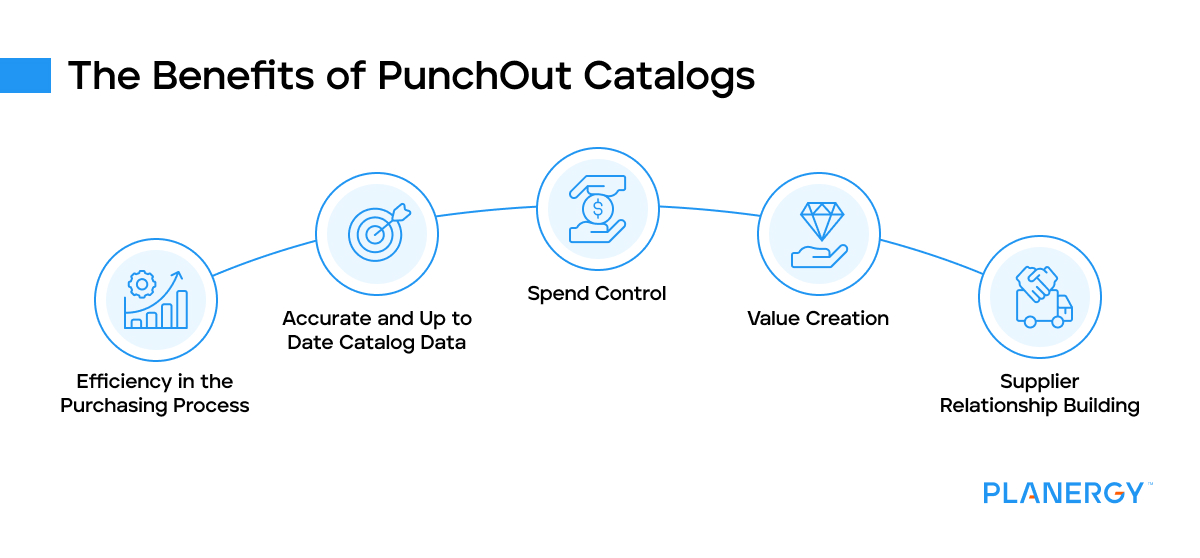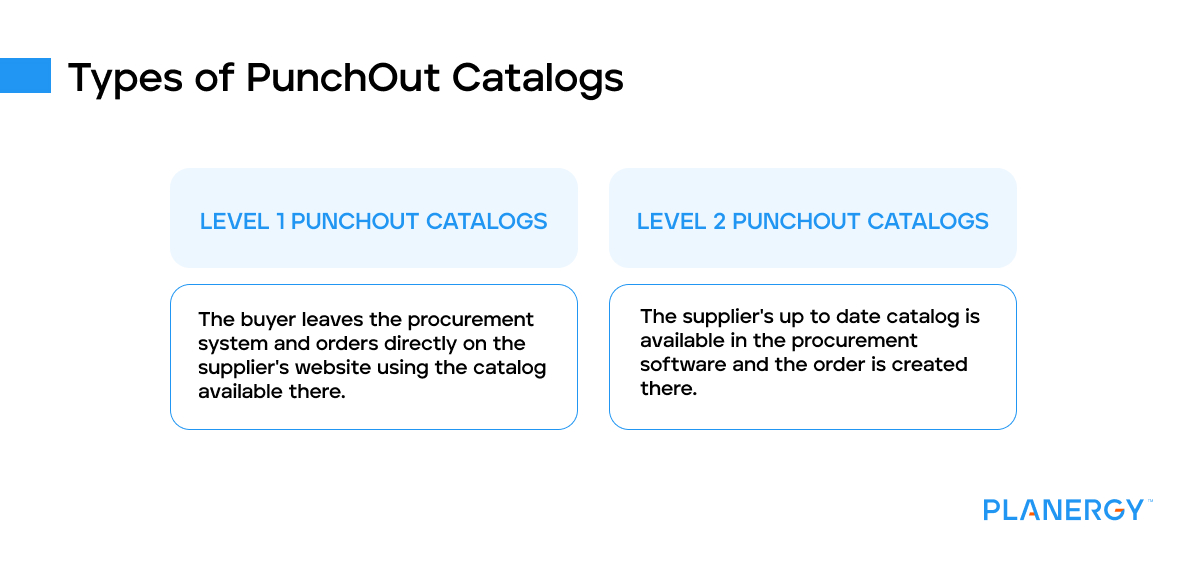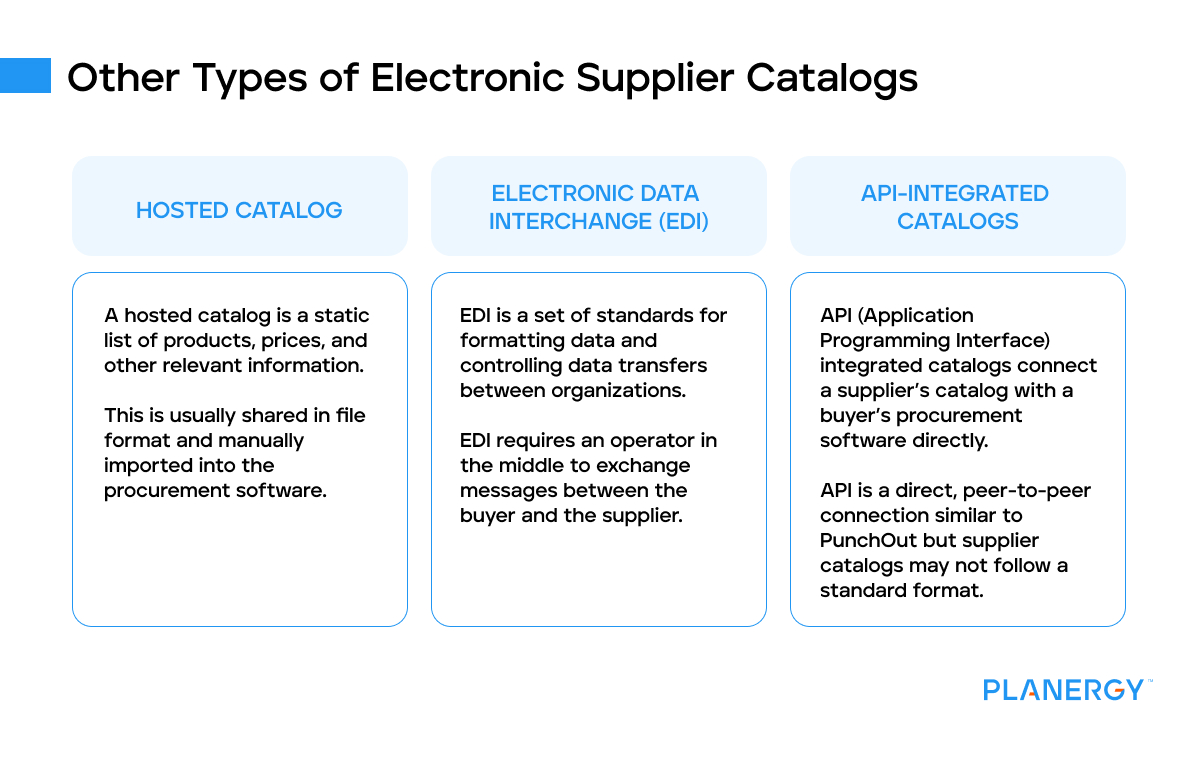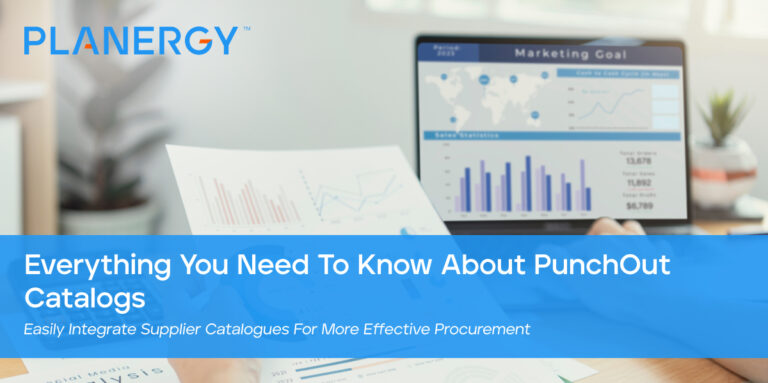Imagine if your procurement system was connected to your entire supplier catalog.
You could browse pre-approved goods at the best pricing and terms available, all without leaving your eProcurement system. A PunchOut catalog makes this dream a reality.
Read on to learn how to create an internal shopping experience that makes purchasing easier while enabling better spend management for your entire organization.
What Does PunchOut Mean in Procurement?
In procurement, PunchOut is an integration between a company’s suppliers and their procurement system to create a streamlined purchasing process for pre-approved items.
It enables procurement teams and employees to access needed items faster and easier than going through external systems to make purchases while directing purchases to preferred vendors and through relevant purchase approval workflows.
What Is a PunchOut Catalog?
A PunchOut catalog (also called a PunchOut website) is a business-to-business (B2B) eProcurement application that allows supplier catalogs to integrate with a buyer’s own procurement application or enterprise resource planning (ERP) solution.
It feeds the buyer’s eProcurement application data directly from the supplier’s product catalogs.
Approved purchasers from the buying organization place items in a shopping cart and check out as they would when completing a personal eCommerce purchase.
Instead of the supplier sending an invoice, the transaction is handled by the buyer’s purchasing system.
This improves efficiency and flexibility compared to the typical purchasing process or static catalog.
PunchOut catalogs create cost savings and efficiency that can add up to a substantial difference in productivity, competitive advantage, and profitability.
What Are the Benefits of PunchOut Catalogs?
While the core benefit of PunchOut catalogs is savings, that savings is created in several ways outlined below.
Efficiency in the Purchasing Process
PunchOut integrations reduce processing time and errors involved with electronic purchase orders, generating savings and efficiency improvements.
Accurate and Up To Date Catalog Data
PunchOut uses cXML(commerce eXtensible Markup Language) and OCI (Open Catalog Interface) technology. cXML, which Ariba created, is a type of XML schema for validating business transactions, and OCI is considered a viable alternative.
Both technologies ensure vendor catalogs are always up to date with real-time, accurate pricing and availability data.
This should include specific negotiated pricing and discounts for your company.
Spend Control
Rogue spend is curtailed as users are pushed towards pre-approved catalog offerings that ensure spend is visible and optimized for the best pre-negotiated price, terms, discounts, and incentives.
Value Creation
PunchOut catalogs add value by freeing procurement staff from tedious low-value tasks like data entry to focus on more important strategic goals.
Improved Supplier Relationships
Stronger and more strategic supplier relationships are created as the free flow of information and improved efficiency can lead to other shared initiatives.
This creates a stronger position for negotiations with suppliers on pricing, terms, and service.

What Are the Different Types of PunchOut Catalogs? (Level 1 and Level 2)
There are two types of PunchOut catalogs that offer a different B2B shopping experience, level 1 and level 2.
Level 1 PunchOut Catalogs
Level 1 PunchOut catalogs are a link to a supplier’s eCommerce website from the buyer’s procurement system.
The buyer is brought to the supplier’s website (punches out), selects what they want to purchase, then their selection is sent back to the procurement system for approval processing.
This allows access to a real-time supplier catalog but requires leaving the procurement system.
Level 2 PunchOut Catalogs
Instead of linking out to a supplier’s site, a level 2 PunchOut catalog brings supplier data into the procurement system itself.
Within the system, buyers can browse through any integrated supplier’s approved items and make purchases.
The distinct advantage of Level 2 PunchOut is that it enables buyers to search and browse through multiple suppliers at the same time, rather than browsing them one by one.
They can see all available options at the same time and compare prices and delivery times. This creates a seamless buying experience with multiple suppliers listed side by side.
Level 2 may require a greater degree of complex data integrations, but it enables higher productivity and helps create savings opportunities.

How Is PunchOut Different From Other Types of Electronic Supplier Catalogs?
There are several other types of catalogs that differ from PunchOut catalogs. The functionality of these catalogs is not as advanced as a PunchOut catalog.
Below we’ll compare three types of alternative catalogs to PunchOut: hosted catalogs, Electronic Data Interchange (EDI), and API-integrated catalogs.
Hosted Catalog vs PunchOut Catalog
A hosted catalog is a static document comprised of details about a supplier’s products and prices.
This is usually shared in file format, often Excel spreadsheet, and manually imported into the procurement software.
Hosted catalogs are simple compared to PunchOut catalogs in that they are essentially a list rather than a full-on integration.
They are easy to use, but they don’t update in real-time and need continuous manual refreshing to stay current on prices and supply levels.
Electronic Data Interchange (EDI) vs PunchOut Catalog
EDI is a set of standards for formatting data and controlling data transfers between organizations.
EDI has a standard format for various document types and transaction types. EDI 832 is the standard format for Price/Sales Catalogs. EDI 850 is the standard format for purchase order documents.
Unlike PunchOut Catalogs, EDI doesn’t actually require internet access. But most modern EDI connections now rely on internet connectivity. The format can enable transactions directly between external networks 24/7.
EDI is not a direct, peer-to-peer integration. It requires an operator in the middle to exchange messages between the buyer and the supplier.
As that is the case, setting up EDI connections can be more complex and costly than setting up PunchOut catalogs.
API-Integrated Catalogs vs PunchOut Catalogs
API (Application Programming Interface) integrated catalogs connect a supplier’s catalog with a buyer’s procurement software via API, which is a common way for software systems to connect.
API is a direct, peer-to-peer connection similar to PunchOut.
The main difference is that APIs do not have a standard format like PunchOut. So integrating with one supplier’s API could be entirely different to working with another’s.
This can mean a lot more work every time you want to integrate with a new supplier.
Each of these methods has its own benefits and pitfalls. Some are easier to implement but provide more limited functionality.
Others don’t necessarily update supplier data in real time.
Comparing the different options, like EDI vs API, will give you a better idea of the best option for your company.
PunchOut integrations are becoming more and more popular and are commonly used by large suppliers, like Amazon Business. Planergy works seamlessly with Amazon Business with our PunchOut integration.

How Do PunchOut Catalogs Work?
PunchOut catalogs work as a part of modern procurement software. They allow buyers to import or integrate vendor catalogs directly into the buyer’s procurement application.
With that, it’s important for procurement teams to ensure that supplier data, file format conversions, and data integrity are all up-to-date by spot-checking supplier catalogs from time to time. Strong catalog management will help.
This is a big advantage over paper-based manual procurement where items from a supplier’s catalog don’t enter a buyer’s purchasing system until after a buyer reviews a static paper or digital catalog.
However, this traditional method is still the way most procurement teams create purchase requisitions and purchase orders, which are sent to the supplier for fulfillment.
Early PunchOut catalogs relied on importing data (rather than real-time integration) using a format invented in the mid-1990s known as catalog interchange format (CIF).
Files in this format transfer supplier catalog data to a buyers procurement system in a comma-separated variable (CSV) layout specifying:
- File header
- Line item data
- File trailer
This allows for easy and intuitive creation of hierarchical relationships (e.g., size, color, material) for a given item while keeping file size and data management costs low.
It also eliminates tedious data entry for product information and reduces or eliminates the need to convert received catalog files.
However, these simpler CIF imports are limited limit compared to real-time eProcurement integrations. CIF also doesn’t support advanced item configurations, and its static nature limits its use to items that aren’t frequently updated.
Modern PunchOut Catalogs address these limitations through the use of two other languages:
Commerce Extensible Markup Language, or cXML.
Open Catalog Interface, or OCI, which is commonly used by System Applications and Products (SAP) and Oracle-based systems.
Today, all PunchOut catalogs (sometimes called PunchOut websites when their interface is distinct from the buyer’s eProcurement interface) are built on cXML and OCI.
These languages support advanced, dynamic configuration and full b2b eCommerce functionality for buyers.
PunchOut Order Example
Imagine Company A is buying goods from Company B via a cXML PunchOut solution.
The transaction would look something like this:
A buyer at Company A accesses the master supplier catalog through their eProcurement application.
The buyer searches for a specific item that’s provided by Company B.
Company B uses a PunchOut site that provides real-time integration with the buyer’s purchasing software. The buyer at Company A is automatically logged into the eCommerce site.
The buyer locates the desired item, configures options such as the quantity, materials, size, and accessories, then adds it to their shopping cart for checkout.
At checkout, the buyer is sent back to the procurement system, which automatically creates a purchase requisition based on the selection and routes it for approval, beginning the internal purchase order approval process at Company A.
Once the order receives the required approval the procurement software communicates with the supplier’s website to finalize the order.

PunchOut Catalogs Are Now the Industry Standard
For large enterprises, PunchOut catalogs have become the expected norm. Buyers at these large companies don’t expect to have to go outside of their procurement system to make purchases.
All of the approved supplier items should be available at their fingertips just by logging into the procurement suite—anything less would be considered inconvenient.
Most modern large organizations expect their employees to use PunchOut catalogs that interface with their preferred suppliers.
This helps them reduce rogue spending, ensures that automation within their e-procurement solution is fully utilized, and streamlines their procurement process.
eProcurement software must offer PunchOut catalogs if they are to be considered viable solutions for modern organizations.
Planergy offers full PunchOut integration, including a standard integration with Amazon Business PunchOut and Punch-in. Planergy is part of the Amazon Business Partner Network.
PunchOut for Greater Productivity and Savings
Purchase by purchase, PunchOut catalogs drive incremental cost savings and efficiency that end up becoming a substantial difference maker for productivity, competitive advantage, and profitability.
They keep your team spending only on the preferred items with your preferred suppliers, encourages the use of your automated procurement system, and improve your standing with preferred suppliers.
If you aren’t yet using PunchOut catalogs, seriously consider making PunchOut integration part of your procurement system.
You will watch the savings and process improvements continue to grow with every purchase.




